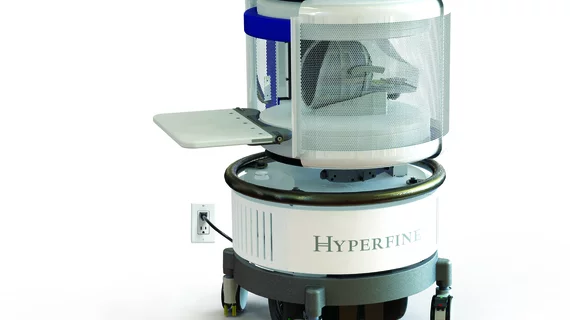FDA clears ‘world’s first’ portable, low-cost MRI following positive clinical research
Magnetic resonance imaging is no longer confined to radiology departments. The U.S. Food and Drug Administration announced Wednesday that it has provided clearance to the “world’s first” bedside MRI system, according to an announcement.
Hyperfine said it will begin shipping its portable, low-field modalities this summer. It’s 510(k) clearance falls on the same day that Yale researchers reported the device can accurately and safely image patient’s brains for stroke. Those preliminary results are set to be presented next week at the American Stroke Association’s International conference in Los Angeles, the group announced.
“We’ve flipped the concept from having to get patients to the MRI to bringing the MRI to the patients,” said Kevin Sheth, MD, senior author and a chief physician at Yale School of Medicine. “This early work suggests our approach is safe and viable in a complex clinical care environment.”
The study included 85 stroke patients who underwent bedside MRI within seven days of experiencing symptoms. A majority of individuals completed the exam, which took an average of 30 minutes. Six experienced claustrophobia and a few couldn’t fit into the machine, but there were no adverse events.
According to Connecticut-based Hyperfine, their machine will cost $50,000, which is 20-times cheaper than traditional systems, runs on 35-times less power and weights 10 times less than normal 1.5T MRI machines.
The FDA clearance includes head imaging for patients 2 years and older, and could help bring the modality to underserved areas such as rural settings and remote villages, said Sheth, who added they’ve “cracked the door open” on bringing this tech to any region.
Sheth also noted that his team will perform further research using this device—built around a 0.064 Tesla magnet—to scan more patients, improve image quality and even employ machine learning to extract vast amounts of its novel imaging data.
For Jonathan Rothberg, PhD, who founded Hyperfine in 2014 and now chairs the company, the goal of revolutionizing how doctors think about MRI is now a reality.
“Nearly six years ago, a dream to create a portable, affordable MRI system was born,” he said in a statement. “We assembled an astounding team, and they took the 10 million-fold improvement in computing power since MRI was invented, the best of the billions invested in green electronics and they built something astonishing, something disruptive.”

